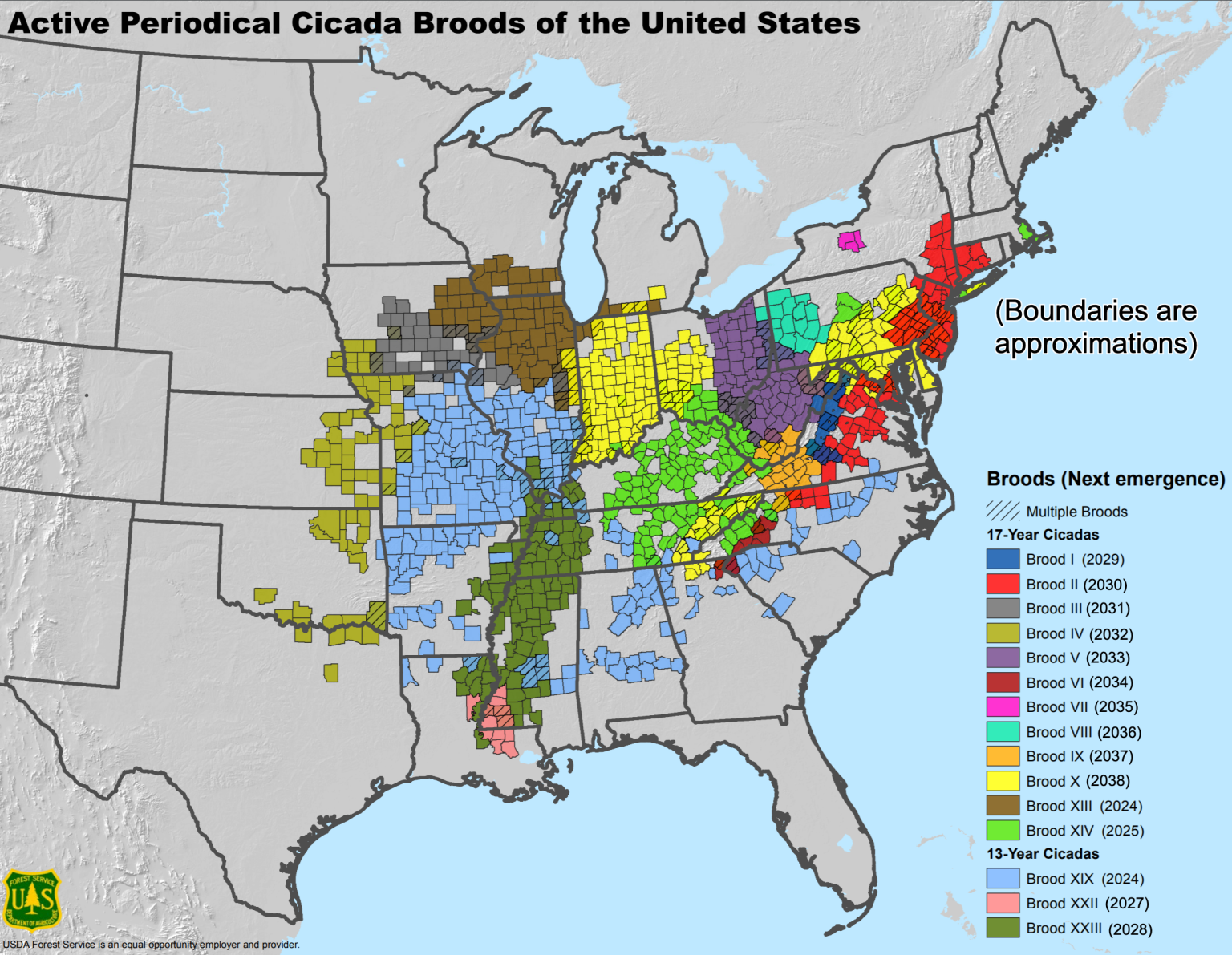
Photo: Periodical cicada broods of the United States and emergence timeline (Courtesy: USDA Forest Service)
As temperatures climb to 64 or 65 degrees Fahrenheit, typically in mid-to-late May, Virginians eagerly anticipate the emergence of cicadas—a familiar symphony of harmless winged wonders renowned for their deafening chorus and periodic mass appearances.
While excitement brews over the impending “Cicadapocalypse” in Virginia, there’s no cause for alarm. Virginia will only witness the emergence of one set of cicadas, while only celect parts of the country will witness multiple broods emerging in tandem. Here in Virginia we prepare for the arrival of Brood XIX, while the epicenter of a dual emergence lies in Illinois. Brood XIII will dominate parts of northern Illinois, Indiana, and possibly extend into neighboring states like Wisconsin and Iowa, setting the stage for a grand cicada extravaganza. Meanwhile, Brood XIX, also known as the Great Southern Brood, boasts a more extensive range, spanning from Missouri to Maryland, including parts of Illinois.
Experts suggest that while the majority of Illinois will witness the emergence of one brood or the other, a narrow strip of land could experience the convergence of both. Despite the vast numbers—trillions of adult cicadas spanning 17 states—the likelihood of encountering both broods simultaneously remains slim. However, for those fortunate enough to witness this convergence, it promises to be a once-in-a-lifetime experience.
Measuring 1 to 2 inches in length with a wingspan of 3 to 4 inches, these buzzing insects may appear imposing to some but pose no harm to humans. Their brief yet intense presence serves as a poignant reminder of nature’s intricate rhythms and the wonders that lie just beneath the surface.

Hi! I’m Jennifer Bailey and I partner with entrepreneurs who have massive ideas that could change the world. Most marketing is meaningless. Filled with empty promises, its only job is to bring in new traffic, new leads, and new customers. But I’ve drawn a line in the sand, and I’ve learned that marketing can do so much more than reach business goals and build profit. My methods give businesses the fire and soul they need to reach the right people, set the groundwork for sustainable relationships, and offer true value to the people on both the giving and receiving ends of marketing.
Subscribe for Updates
Sponsors
latest articles
“Mineral Deserves Better” Vice Mayor Chapman Calls for Accountability, Addresses Concerns Facing Mineral

Miller’s Market Gas Pumps Controversy Continues; Town of Mineral Delays Construction

33rd Annual Orange Uncorked Wine Festival: A Celebration of Virginia’s Finest Wines

From Lake Anna to the World’s Stage: Huntley’s Voice Echos into Triumph

Aliens are Real [Letter from the Editor]
![Featured image for “Aliens are Real [Letter from the Editor]”](https://lakeanna.online/wp-content/uploads/2024/04/LAMG-Social-Media-Template-Set-Landscape-4.png)
One Leash, Two Lives: Former Marine Finds New Mission to Save Lives through Service Dogs

Photo: Periodical cicada broods of the United States and emergence timeline (Courtesy: USDA Forest Service)
As temperatures climb to 64 or 65 degrees Fahrenheit, typically in mid-to-late May, Virginians eagerly anticipate the emergence of cicadas—a familiar symphony of harmless winged wonders renowned for their deafening chorus and periodic mass appearances.
While excitement brews over the impending “Cicadapocalypse” in Virginia, there’s no cause for alarm. Virginia will only witness the emergence of one set of cicadas, while only celect parts of the country will witness multiple broods emerging in tandem. Here in Virginia we prepare for the arrival of Brood XIX, while the epicenter of a dual emergence lies in Illinois. Brood XIII will dominate parts of northern Illinois, Indiana, and possibly extend into neighboring states like Wisconsin and Iowa, setting the stage for a grand cicada extravaganza. Meanwhile, Brood XIX, also known as the Great Southern Brood, boasts a more extensive range, spanning from Missouri to Maryland, including parts of Illinois.
Experts suggest that while the majority of Illinois will witness the emergence of one brood or the other, a narrow strip of land could experience the convergence of both. Despite the vast numbers—trillions of adult cicadas spanning 17 states—the likelihood of encountering both broods simultaneously remains slim. However, for those fortunate enough to witness this convergence, it promises to be a once-in-a-lifetime experience.
Measuring 1 to 2 inches in length with a wingspan of 3 to 4 inches, these buzzing insects may appear imposing to some but pose no harm to humans. Their brief yet intense presence serves as a poignant reminder of nature’s intricate rhythms and the wonders that lie just beneath the surface.

Hi! I’m Jennifer Bailey and I partner with entrepreneurs who have massive ideas that could change the world. Most marketing is meaningless. Filled with empty promises, its only job is to bring in new traffic, new leads, and new customers. But I’ve drawn a line in the sand, and I’ve learned that marketing can do so much more than reach business goals and build profit. My methods give businesses the fire and soul they need to reach the right people, set the groundwork for sustainable relationships, and offer true value to the people on both the giving and receiving ends of marketing.
Subscribe for Updates
Sponsors
latest articles
“Mineral Deserves Better” Vice Mayor Chapman Calls for Accountability, Addresses Concerns Facing Mineral

Miller’s Market Gas Pumps Controversy Continues; Town of Mineral Delays Construction

33rd Annual Orange Uncorked Wine Festival: A Celebration of Virginia’s Finest Wines

From Lake Anna to the World’s Stage: Huntley’s Voice Echos into Triumph

Aliens are Real [Letter from the Editor]
![Featured image for “Aliens are Real [Letter from the Editor]”](https://lakeanna.online/wp-content/uploads/2024/04/LAMG-Social-Media-Template-Set-Landscape-4.png)
One Leash, Two Lives: Former Marine Finds New Mission to Save Lives through Service Dogs


“Mineral Deserves Better” Vice Mayor Chapman Calls for Accountability, Addresses Concerns Facing Mineral
Article By Jen Bailey

Miller’s Market Gas Pumps Controversy Continues; Town of Mineral Delays Construction
Article By Debbie Moon








